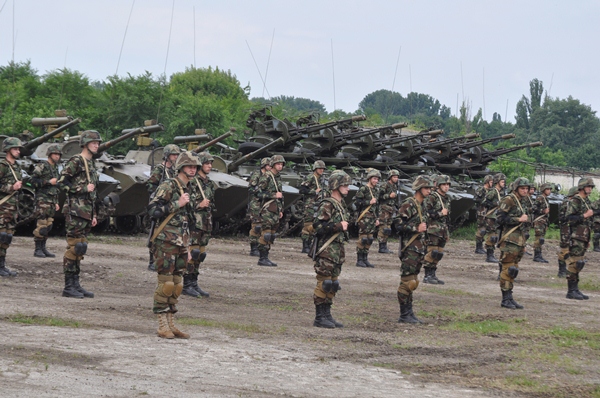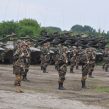
Moldovan Armed Forces Train for Hybrid Warfare the Wrong Way
Publication: Eurasia Daily Monitor Volume: 11 Issue: 194
By:

In its latest display of mission readiness (in mid-October 2014), the special forces brigade “Fulger” (Thunderbolt) of the Moldovan Ministry of Interior provided a massive show of force by conducting a field exercise involving 350 of its 500-strong force (publika.md, October 22). The exercise featured columns of SWAT personnel and infantry armored vehicles moving through the streets of the national capital, hand-to-hand combat performances, and nation-wide media coverage.
It may seem that Moldovan authorities are preparing to deal with the “hybrid”-type war that Ukraine is currently fighting. However, some of the elements of these exercises have drawn a number of criticisms. First, the October exercise was not conducted at the Fulger brigade’s remote training ranges, as is customary. Second, it did not involve practicing recovering control over government buildings captured by rebel or militia forces—a necessary skill emphasized by Ukraine’s experience. Instead, the Fulger brigade’s widely publicized exercise was unmistakably designed to impress the public and raise its confidence before the November 30 parliamentary elections.
This questionable approach to combat training is not a separate incident. The Moldovan National Army has been performing window dressing exercises for the last several months, in an apparent attempt to impress the political leadership. After the appointment of Valeriu Troenco as the new minister of defense in April 2014, the military top brass felt the pressure to prove its worthiness. The key emphasis was placed on the overhaul and repair of military vehicles that had not been operated for years, accumulating rust in their Soviet-era depots. This past spring, Minister Troenco personally inspected a number of military units, including the motorized infantry brigades in Cahul (army.md, April 30) and Chisinau (army.md, May 21). Following that, Troenco invited the members of the parliamentary committee on national security, defense, and public order to witness the visually impressive parade of Chisinau-based infantry brigade armored vehicles (army.md, June 18).
Undoubtedly, making the National Army’s military vehicles operational again is a good place to start if the government truly wishes to prepare Moldova to confront a potential hybrid war. However, the described efforts are a typical example of what was famously referred to in the Soviet military as “pokazukha”—the often ridiculous actions aimed at creating falsely favorable appearances of troop combat readiness, in order to impress superiors and receive commendations. For instance, in the Soviet Union, it was customary to paint the dry grass green on the territory of military bases before the visits of high-level inspectors. The pokazukha happens both due to the incompetence of senior members of the officer corps, and due to the lack of resources to provide for real combat readiness.
Ukraine’s experience this past year suggested a number of things, which were not considered by the Moldovan government. First, just like Ukraine, Moldova faces a lack of military hardware spare parts, fuel, munitions, body armor, food supplies, and light anti-tank weapons. Moldova’s annual defense budget has mostly oscillated between 0.3 and 0.6 percent of GDP for the last several years, staying below $30 million in real terms. Most of the funding goes into salaries for contracted personnel and the subsistence of the conscripted soldiers—during 2009–2013, the defense budget did not cover combat training at all (army.md, accessed on October 28). For comparison, Moldova gave almost three times more funding to its Ministry of Interior and the affiliated carabinieri troops in 2014 (parlament.md, accessed on October 28).
The lack of funding is only a part of the problem, however. Moldova’s Armed Forces, as the “Fulger” brigade example revealed, do not even efficiently use their existing resources. This year, the National Army conducted a number of field exercises, including live-fire training, which involved the infantry brigades from Balti (army.md, June 4), Cahul (army.md, June 25), Chisinau, as well as its air defense (army.md, August 8) and artillery units (army.md, August 14). But reportedly, the exercises followed either peacekeeping or conventional combat scenarios, both of which are poorly suited to fight a true hybrid war.
Moreover, as was illustrated by the Ukrainian military’s extremely high losses in hardware and personnel during the Anti-Terrorism Operation (ATO), in the absence of total control over one’s airspace, even a three-to-one military superiority is insufficient to successfully advance against lightly armed rebels by employing WWII-style conventional tactics. Therefore, the funding that Moldova used to run all these recent window-dressing exercises could have been instead diverted to train military personnel for small-unit combat. Moreover, the Moldovan Armed Forces may have wanted to explore the elements of what Stephen Biddle, an adjunct senior fellow for defense policy at the Council on Foreign Relations, labeled the modern system: a complex of cover, concealment, dispersion, small-unit maneuver, and suppression (Stephen D. Biddle, Military Power: Explaining Victory and Defeat in Modern Battle, Princeton University Press: Princeton, NJ, 2004).
The Ukrainian case suggests that military personnel need to be prepared to fight in densely populated urban and rural areas, where the use of indiscriminate artillery fire is absolutely counterproductive. Besides destroying the economic infrastructure, this approach also antagonizes the local population, making it more difficult to later reintegrate it back into a unified country. Also, while the military has to avoid using artillery against rebel forces defending their positions in inhabited areas, it should expect that these rebels will themselves use such tactics against the Moldovan troops and train to deal with it.
Judging by the exercises of its Armed Forces, the Moldovan government has apparently yet to thoroughly examine the hybrid war mechanism in Ukraine and learn from its neighbor’s mistakes. The so-called hybrid warfare tactics can be stripped down to five elements: 1) a de-legitimization media campaign aiming to influence the population’s preferences by altering their perceived needs; the political subversion stage that, according to a RAND, study includes 2) the creation of front groups to gain public credibility, 3) the infiltration of state—and particularly military and law enforcement—institutions, 4) and the corroding of governmental power by fomenting riots, staging violent demonstrations, and generally igniting civil unrest (rand.org, 2007); 5) as well as the final stage that replaces legitimate power by forcefully taking over government buildings and disabling local law enforcement and military units.
The fifth element is of key importance for the success of the rebels, representing their Clausewitzian center of gravity. It is also where the Moldovan Armed Forces have thus far failed to focus their training efforts—not having learned to defend or quickly recover control over administrative centers and governmental buildings.




